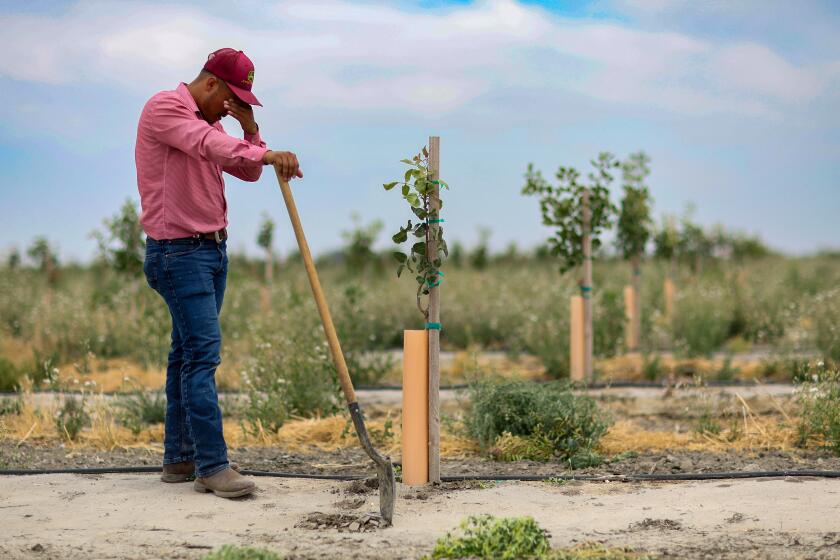Greenbelt Vote Pits Panel Against 2 Groups : Development: Zoning debate between pro-growth landowners and environmental interests will be revived at Ventura City Council meeting tonight.
Caught in the middle of a political rematch between environmental and pro-growth forces, the Ventura City Council tonight is scheduled to vote on whether to establish a greenbelt that would restrict development of almost 5,000 acres of prime farmland between Ventura and Oxnard.
The area is unincorporated county land, but already zoned only for agricultural use under the long-term planning guides of both Ventura and Oxnard, which plan to eventually annex portions of the area.
About 1,700 acres of the proposed 4,796-acre greenbelt lie on Ventura’s side of the Santa Clara River. The bulk of the proposed greenbelt is south of the Santa Clara River and will eventually become part of Oxnard.
The proposed greenbelt stretches north from Wooley Road in Oxnard to the Southern Pacific railroad tracks near the Ventura Harbor, and is bordered on the east and west by Harbor Boulevard and Victoria Avenue.
Ventura’s Comprehensive Plan calls for the area to remain agricultural until the year 2010 and Oxnard’s General Plan designates its proposed greenbelt area to stay agricultural until the year 2020.
But both plans direct that city staff work toward additional designation of the area as a greenbelt. Unlike the Comprehensive Plan, a greenbelt agreement is not legally binding and is only a policy statement in which Ventura and Oxnard would pledge not to develop in the area.
The issue of whether to zone the area for agriculture was hotly debated in Ventura four years ago during hearings on the city’s Comprehensive Plan. Now that the greenbelt issue has reached the council, it has revived the old debate about development in Ventura.
Slow and no-growth proponents want the greenbelt designation because it would be another political obstacle for developers to face. For the same reason, landowners in the greenbelt are against the designation because they feel it might make it more difficult to eventually develop their property.
Under the proposed measure, the council would designate the area as a greenbelt for five years, then review it. The five-year review is seen by some pro-development advocates as an acceptable compromise during which time they could muster community support for developing in the greenbelt.
Ventura city officials said the five-year clause was suggested by Oxnard city staff and recommended by the Ventura Planning Commission. An early version of the measure would have imposed the greenbelt designation for an indefinite period.
Councilman Jack Tingstrom has aligned himself with pro-development forces seeking defeat of the greenbelt designation. He helped some property owners get in contact with Orange County developer Hardy Strozier, who was a vocal opponent to the Comprehensive Plan and who wanted to create a plan to develop the agricultural area.
Landowners later rejected Strozier in favor of another development company, the Santa Barbara-based Berkus Group. The group has also proposed drafting a plan to develop the proposed greenbelt area.
Property owners are now lobbying city council members to reject or postpone a decision about the five-year greenbelt designation until they can present an alternate plan for the area: a planned community of commercial and residential development.
“If this vote comes down and it becomes greenbelt, it would stop us in our tracks,” said Vic Ouimette, a landowner who argues that the nearby Ventura Harbor needs residential and commercial development to support it. Ouimette leases out his land to a farmer who grows flowers.
Ventura Councilwoman Cathy Bean, an ardent supporter of the greenbelt, said she would not be receptive to a proposed alternate development plan by landowners.
“The city should do the planning, not developers,” Bean said.
She noted that any plans to develop the proposed greenbelt area in the near future would be in violation of the Comprehensive Plan, a legally binding document used as a planning guide for the city’s future.
Tingstrom said he and the property owners have no intention of ignoring the Comprehensive Plan and changing the agricultural zoning before 2010, but he observed the plan will be up for review before then.
“Am I bound by what another city council did?” said Tingstrom, who has consistently voted in favor of development. “If I can get four votes, we can do anything.”
Tingstrom said Strozier had approached him over a year ago about developing the land in the proposed greenbelt. Tingstrom said he introduced Strozier to the property owners and warned them that city officials would designate their land a greenbelt if they did not present an alternate development plan.
Tingstrom defends himself against critics who said he overstepped his bounds as a neutral council member.
“I’m representing my constituency. All I’m trying to do is give some advice to some property owners,” Tingstrom said. “I told them, ‘The greenbelt is coming, and you better get off your dead ass and do something about it.’ ”
Strozier did not return repeated phone calls to his office.
No development plans for the proposed greenbelt area have been drafted because property owners said they are waiting to see what the council will do today.
Tingstrom said that although he favors adhering to the city’s Comprehensive Plan, “above all, I believe in property owners’ rights.”
Some property owners who want to develop their land said they would not mind waiting until 2010. But what does worry landowners is that a greenbelt designation by the council could restrict development past 2010--maybe indefinitely.
Developers can always push to build in the area, but a greenbelt agreement would make it more difficult, landowners said.
“Even though a greenbelt isn’t legally binding, politically it has a lot of clout,” said Pat Richardson, a senior planner for the city.
Tom McLoughlin, whose family owns about 300 acres in the proposed greenbelt area, said alternate development for the greenbelt would include donating open space for parks and recreational use by Ventura residents.
A greenbelt designation would still mean that residents cannot trespass onto private property, McLoughlin said. But if a development was allowed, about 800 to 1,000 acres of open space could be donated to the city and could be used for parks, he said.
“These guys are taking our options away from us,” said McLoughlin, who leases out his land for celery and mixed lettuce crops. “If they put that greenbelt on it, they take away any possibility of potential development.”
The area is considered some of the best farmland in the nation. About 35 landowners on Ventura’s side of the greenbelt would be affected, city officials said.
Farmers have been growing lemons, strawberries, celery, cabbage and lettuce in the area for decades. Proponents argue that the greenbelt is essential to maintaining the agricultural industry in Ventura County. Advocates for the greenbelt include the League of Women Voters of Ventura County, the local chapter of the Sierra Club and environmental groups.
“We’re talking about the biggest industry in this county and destroying it,” Councilwoman Bean said. “There are people out there who don’t care about agriculture and want to take the money and run. It’s economically sound for this county to remain agricultural.”
But Rex Laird, executive director of the Ventura County Farm Bureau, said farmers oppose the greenbelt designation because “a greenbelt does nothing to the property, and many growers see it as an intrusion.”
Laird dismissed concerns that development in the proposed greenbelt would benefit the county’s agricultural industry.
“The hard fact is that this greenbelt will not make or break Ventura County agriculture,” he said.
Efforts have been made to develop the area since 1978, including a proposal to convert the site for a four-year state university. Last year, five farm families who own the 297-acre parcel between Harbor Boulevard and Olivas Park Drive sued the city of Ventura and Ventura County to permit development of their property or pay the landowners $75 million in damages.
The plaintiffs later dropped the lawsuit, said City Atty. Peter D. Bulens. No reason was given, he said.
“I guess they were rattling sabers,” Bulens said.
City planner Richardson noted that the greenbelt agreement may never occur even if Ventura officials approve it. Plans call for both cities to establish the greenbelt, and if Oxnard officials balk, then Ventura would have to wait for a greenbelt, he said.
“This thing could be dead by the time Oxnard gets through with it,” Richardson said.
Last month, the Oxnard Planning Commission deadlocked on whether to support the greenbelt agreement and is scheduled to consider it again this week. In a few months, the Oxnard City Council will make its decision on the proposed greenbelt.
More to Read
Sign up for Essential California
The most important California stories and recommendations in your inbox every morning.
You may occasionally receive promotional content from the Los Angeles Times.






